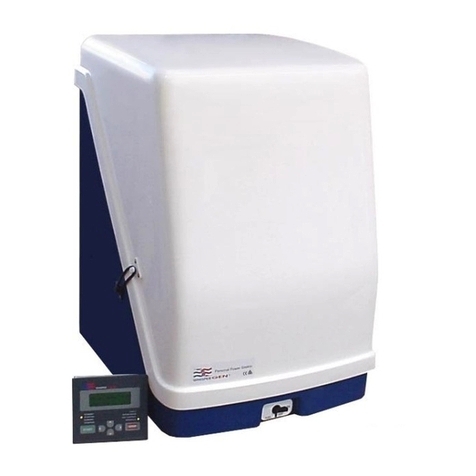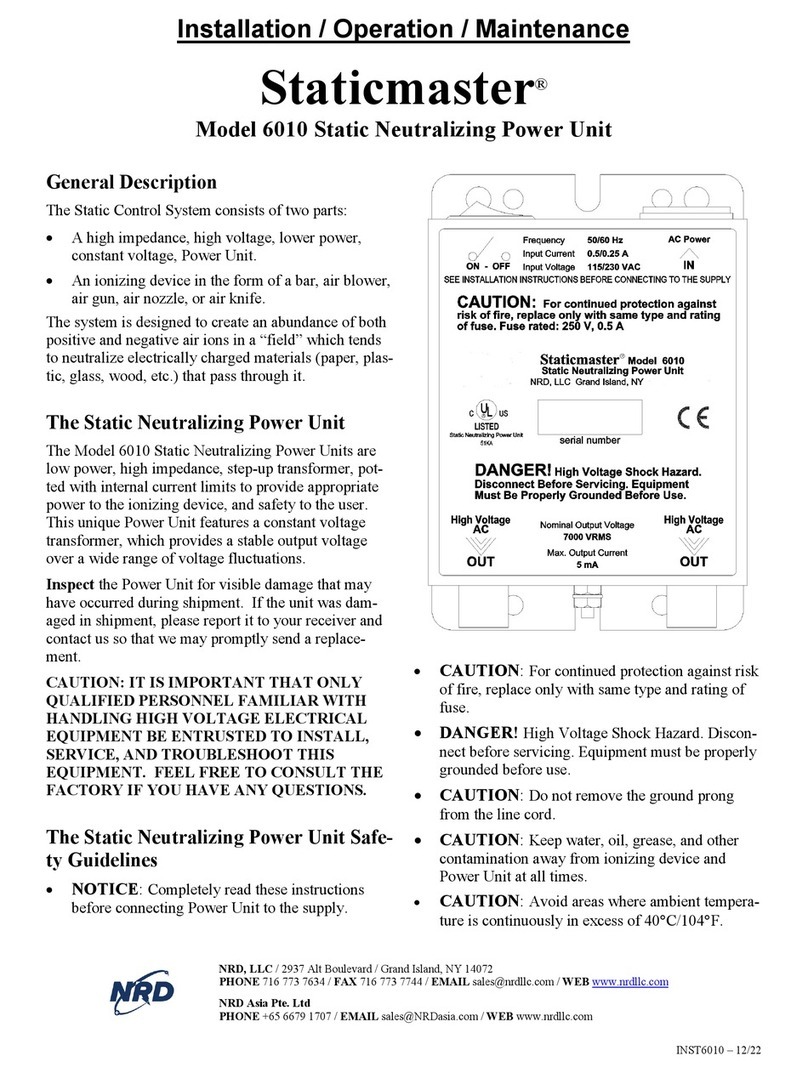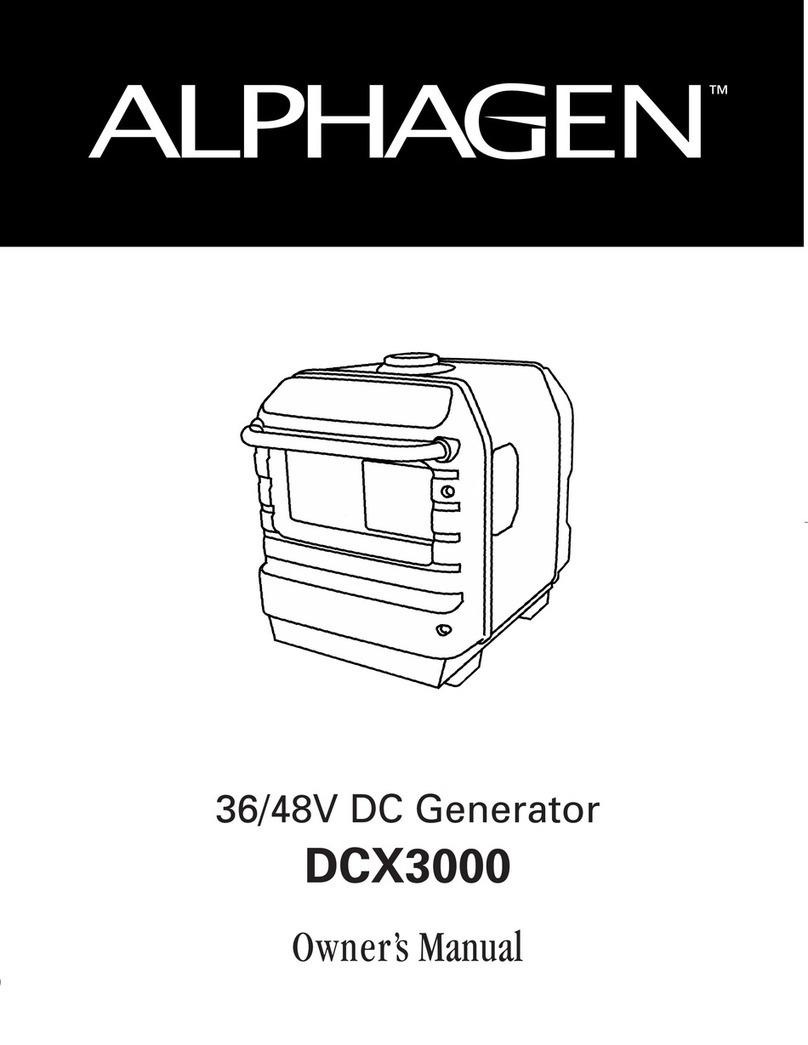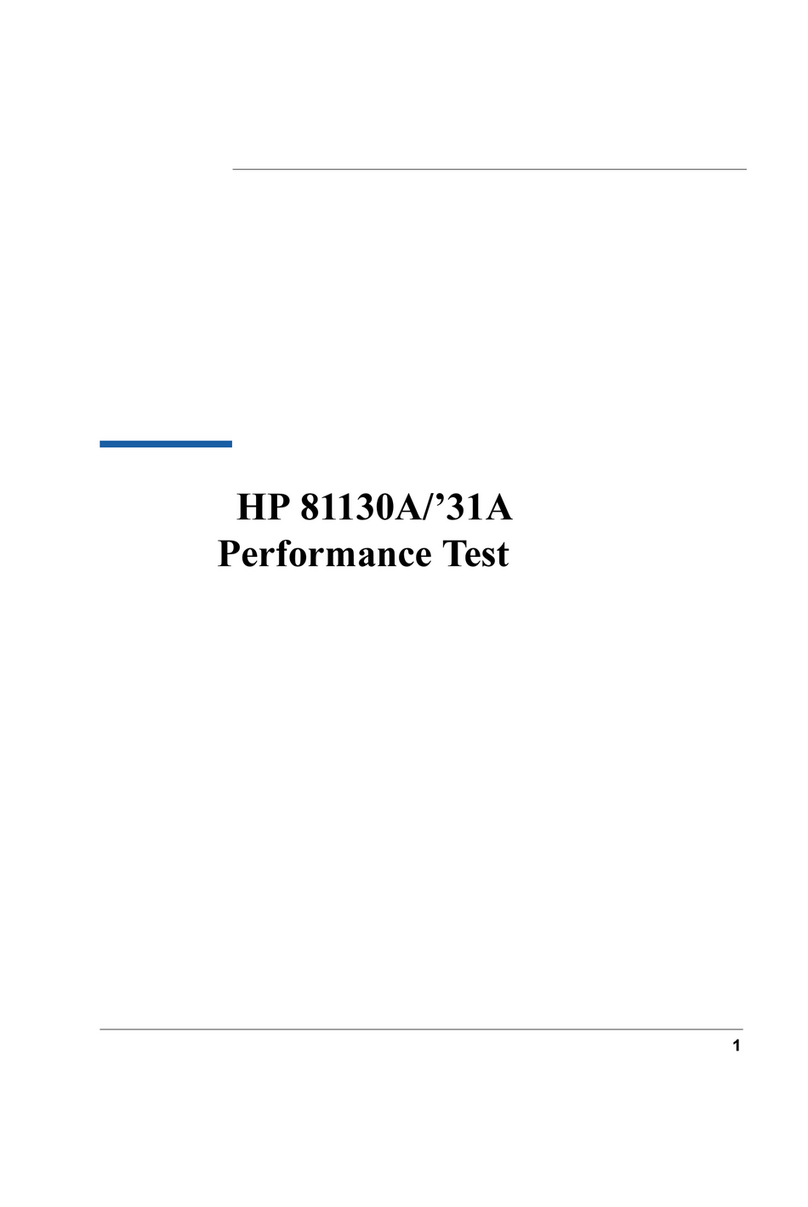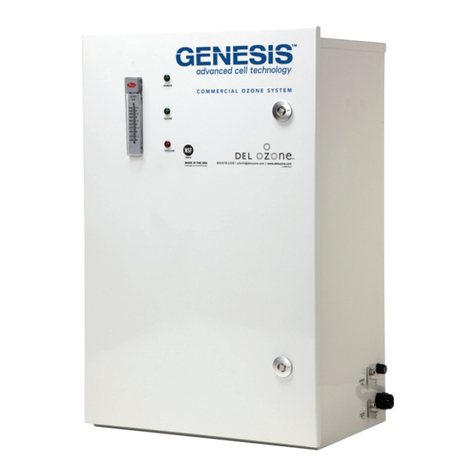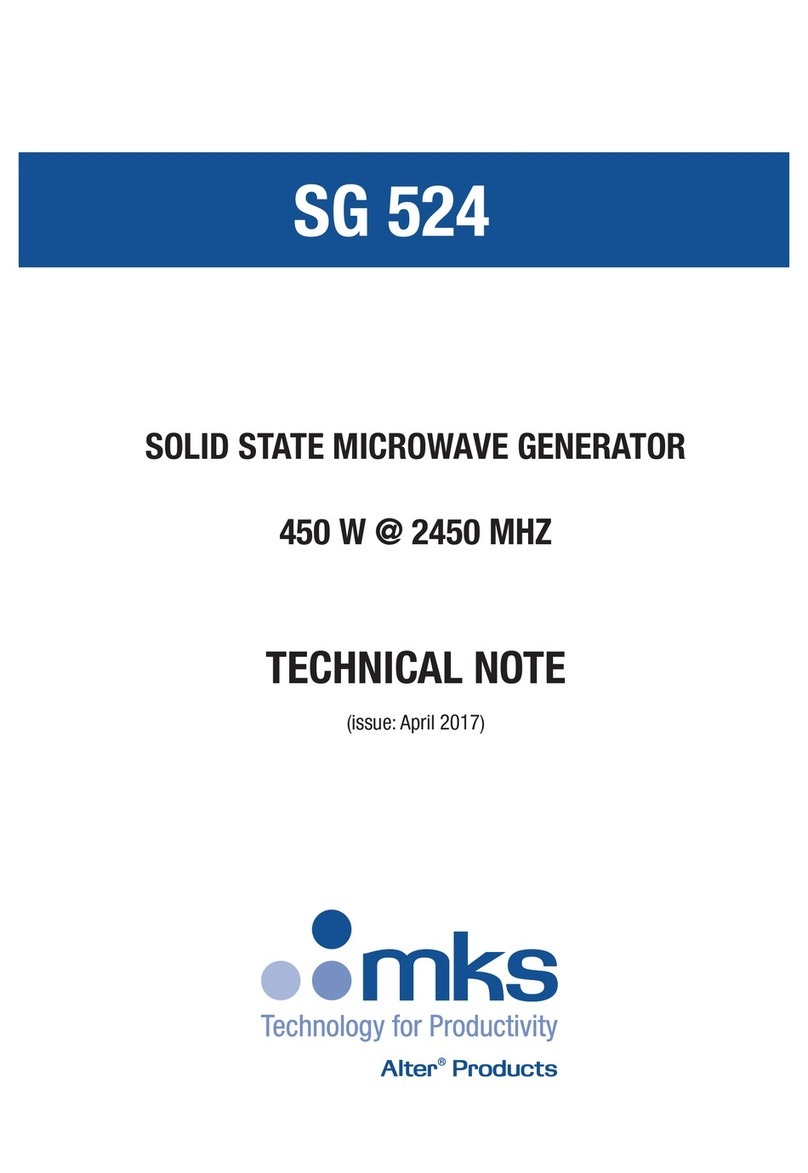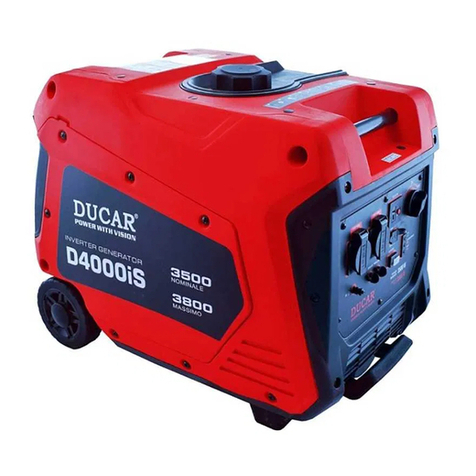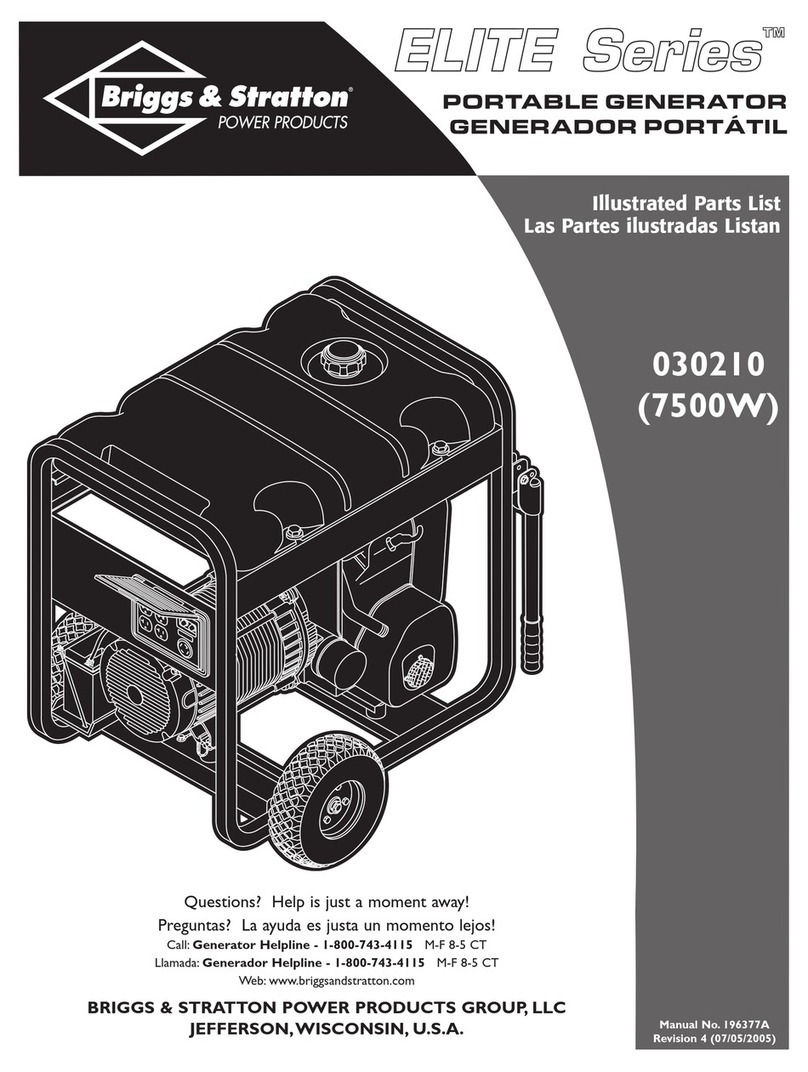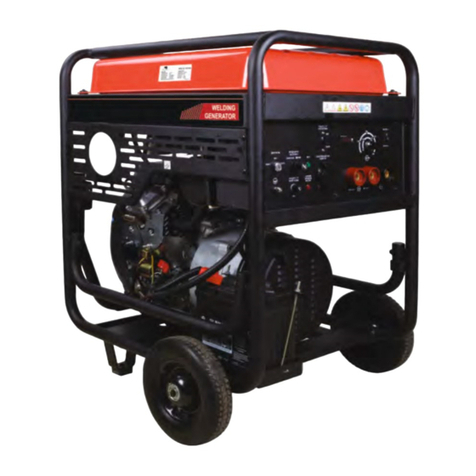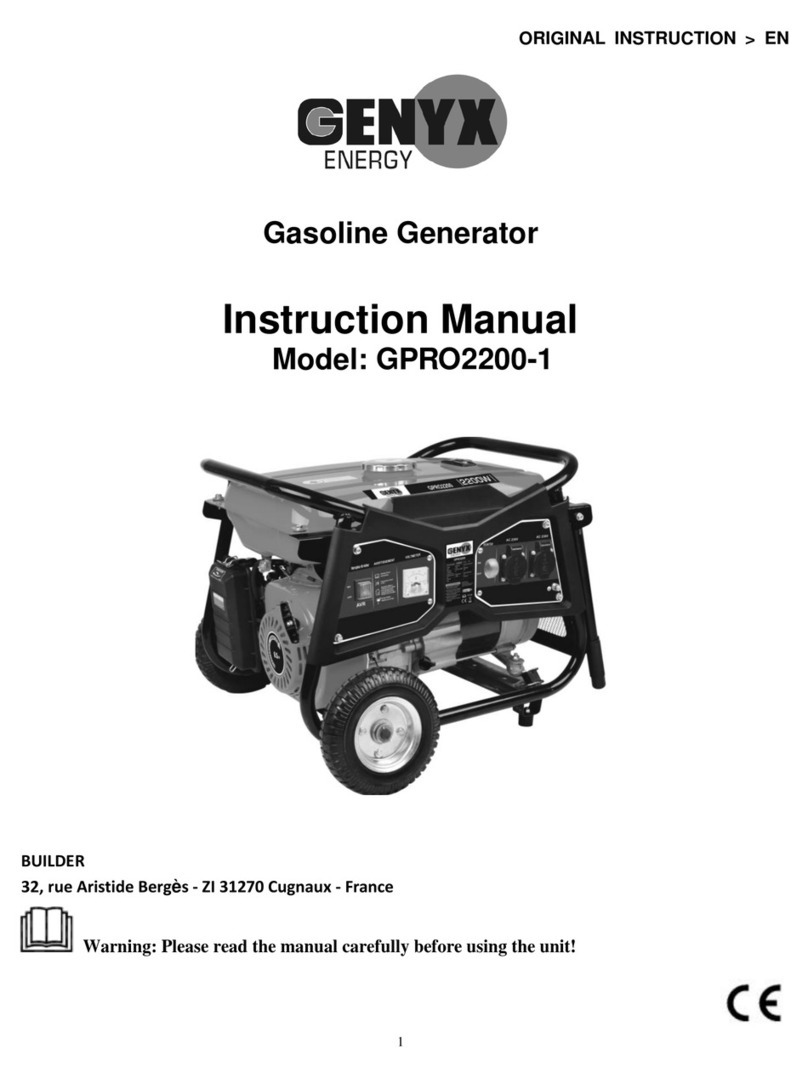KAWASHIMA PRO2000i User manual

Operating Instructions and Manual
Kawashima
Guaranteed Pure
Sine Wave
INVERTERGENERATOR

Kawashima
We Appreciate Your Business.
Thank you and congratulations for choosing Kawashima.
You have invested in a machine that will last a lifetime if you follow
strictly the maintenance and care guidelines set out in this manual.
This Operating Manual has been designed to instruct you on the
correct use and operation of your Kawashima product. Your
satisfaction with this product and its safe operation is our ultimate
concern. Therefore please take the time to read the entire manual,
especially the Safety Precautions. They will help you to avoid
potential hazards that may exist when working with this product.
.
WARNING!
READ AND UNDERSTAND ALL SAFETY PRECAUTIONS IN THIS MANUAL
BEFORE OPERATING. FAILURE TO COMPLY WITH INSTRUCTIONS IN THIS
MANUAL COULD RESULT IN PERSONAL INJURY, PROPERTY DAMAGE,
AND/ OR VOIDING OF YOUR WARRANTY. KAWASHIMA WILL NOT BE
LIABLE FOR ANY DAMAGE BECAUSE OF FAILURE TO FOLLOW THESE
INSTRUCTIONS.

Table of Contents
1. SECTION 1: SAFETY INSTRUCTIONS AND WARNINGS ....................1-1
1.1 Symbol Usage..........................................................................................1-1
1.2 General Safety Precautions.....................................................................1-2
2. SECTION 2: CONTROLS AND FEATURES ..........................................2-1
2.1 Generator ................................................................................................2-1
2.2 Control Panel ..........................................................................................2-2
2.3 Control Functions ....................................................................................2-3
3. SECTION 3: GETTING STARTED .........................................................3-1
3.1 Unpack the Generator .............................................................................3-1
3.2 Adding Engine Oil ...................................................................................3-1
3.3 Adding Fuel .............................................................................................3-2
3.4 Starting the Engine .................................................................................3-4
3.5 Stopping the Engine ................................................................................3-6
4. SECTION 4: ELECTRICAL CONNECTION ...........................................4-1
4.1 Capacity ..................................................................................................4-1
4.2 Power Maintenance ................................................................................4-1
4.3 Connecting Electrical Loads ....................................................................4-1
4.4 Battery Charging……………………………………………………………….4-2
4.5 Wattage Reference Guide…………………………………………………….4-3
5. SECTION 5: MAINTENANCE .................................................................5-1
5.1 Periodic Maintenance ..............................................................................5-1
5.2 Spark Plug Maintenance .........................................................................5-2
5.3 Engine Oil Replacement .........................................................................5-3
5.4 Air Filter Maintenance .............................................................................5-4
5.5 Muffler Screen & Spark Arrestor Maintenance ........................................5-5
5.6 Fuel Filter Maintenance ...........................................................................5-6
6. SECTION 6: STORAGE .........................................................................6-1
6.1 Long Term Storage .................................................................................6-1
7. SECTION 7: TROUBLESHOOTING AND SPECIFICATIONS ...............7-1
7.1 Troubleshooting Diagram ........................................................................7-1
7.2 Fuel Filter Maintenance ...........................................................................7-2
7.3 Specifications ..........................................................................................7-3

1-1
SECTION 1:
SAFETY INSTRUCTIONS AND WARNINGS
1.1 Symbol Usage
This manual contains important information that you need to know and understand
in order to assure YOUR SAFETY and PROPER OPERATION OF EQUIPMENT.
The following symbols help you recognize this information. Please read the
manual and pay attention to these sections.
Save These Important Safety Instructions!
Read and understand all of these safety instructions. Be sure to
retain them for future use.
WARNING!
WARNINGS INDICATE A CERTAINTY OR STRONG
POSSIBILITY OF PERSONAL INJURY OR DEATH IF
INSTRUCTIONS ARE NOT FOLLOWED.
CAUTION:
CAUTIONS INDICATE A POSSIBILITY OF EQUIPMENT
DAMAGE IF INSTRUCTIONS ARE NOT FOLLOWED
PROPERLY.
Note:
Notes give helpful information
Gasoline powered and electrical generating products can cause serious injury or
death, or damage to other equipment or property, if the operator does not strictly
observe all safety rules and take precautionary actions.

1-2
1.2 General Safety Precautions
WARNING!
FAILURE TO FOLLOW THESE INSTRUCTIONS CAN
RESULT IN SEVERE INJURY OR DEATH.
CAUTION:
FAILURE TO FOLLOW THESE INSTRUCTIONS CAN ALSO
RESULT IN DAMAGE TO THE EQUIPMENT AND/OR THE
ITEM YOU ARE WORKING ON OR WITH.
Carbon Monoxide
•
Carbon Monoxide is an odourless and colourless gas. Breathing
exhaust that contains this poisonous gas can cause
unconsciousness and may lead to death.
•
The engine exhaust from this product contains chemicals
recognized by the state of California to cause cancer, birth
defects, or other reproductive harm.
•
When this tool is running, ensure that the area is well ventilated.
Never run the engine in an enclosed area. Run the engine in an open
area or with an exhaust evacuation system in an enclosed area.
•
NEVER use a generator inside homes, garages, crawlspaces, or
other partially enclosed areas. Deadly levels of carbon monoxide can
build up in these areas. Using a fan or opening windows and doors
does NOT supply enough fresh air.
•
ONLY use a generator outdoors and far away from open windows,
doors, and vents. These openings can pull in generator exhaust.
•
Even when you use a generator correctly, CO may leak into the
home. ALWAYS use a battery-powered or battery-backup CO alarm
in the home.
•
If you start to feel sick, dizzy, or weak after the generator has
been running, move to fresh air RIGHT AWAY. See a doctor. You
could have carbon monoxide poisoning.
WARNING!
THE EXHAUST CONTAINS POISONOUS CARBON
MONOXIDE GAS THAT CAN CAUSE LOSS OF
CONSCIOUSNESS AND MAY LEAD TO DEATH.

1-3
Gasoline and Oil
This product requires oil and fuel. THE ENGINE WILL NOT START
WITHOUT OIL. Work in well-ventilated area. Keep cigarettes, flames or
sparks away from the work area or where gasoline is stored.
WARNING!
GASOLINE IS EXTREMELY FLAMMABLE AND IS
EXPLOSIVE UNDER CERTAIN CONDITIONS. KEEP OUT OF
REACH OF CHILDREN.
•
Gasoline fuel and fumes are flammable and potentially explosive.
Use proper fuel storage and handling procedures. Always have
multiple ABC class fire extinguishers nearby.
•
Keep the generator and surrounding area clean at all times.
Keep the generator at least 5 feet away from buildings and other
equipment during operation.
•
Fuel or oil spills must be cleaned up immediately. Dispose of fluids
and cleaning materials as per any local, state, or federal codes and
regulations. Store oily rags in a covered metal container.
•
Never store fuel or other flammable materials near the generator.
•
Do not smoke, or allow sparks, flames or other sources of
ignition around the engine and fuel tank. Fuel vapours are
explosive.
•
Keep earthed conductive objects, such as tools, away from
exposed, live electrical parts and connections to avoid sparking or
arcing. These events could ignite fumes or vapours.
•
Do not refill the fuel tank while the engine is running or while the
engine is still hot. Do not operate the generator with known leaks in
the fuel system.
•
Excessive build-up of unburned fuel gases in the exhaust system can
create a potentially explosive condition. This build-up can occur after
repeated failed start attempts, valve testing, or hot engine shutdown.
•
Use only engine manufacturer recommended fuel and oil.

1-4
Hot Components
WARNING!
HOT EXHAUST CAN BURN YOU. ENGINE AND EXHAUST
SYSTEM PARTS BECOME VERY HOT AND REMAIN HOT
FOR SOME TIME AFTER THE ENGINE IS RUN. WEAR
INSULATED GLOVES OR WAIT UNTIL THE ENGINE AND
EXHAUST SYSTEM HAVE COOLED BEFORE HANDLING
THESE PARTS.
Work Area
•
Keep your work area clean and well lit. Cluttered benches and dark
areas invite accidents.
•
Do not operate power tools in explosive atmospheres, such as in the
presence of flammable liquids, gases, or dust. Generators create
sparks which may ignite the dust or fumes.
•
Keep bystanders, children, and visitors away while operating a
generator. Provide barriers or shields as needed.
Electrical Safety
•
Keep all electrical equipment clean and dry. Replace any wiring
where the insulation is cracked, cut eroded part or otherwise
degraded. Replace terminals that are worn, discoloured, or
corroded. Keep terminals clean and tight.
•
Insulate all connections and disconnected wires.
•
Do not abuse the power cord. Keep power cords away from heat, oil,
sharp edges, or moving parts. Replace damaged power cords
immediately. Damaged power cords increase the risk of electric
shock.
•
Do not operate the generator with wet hands. Do not expose
generator to rain, snow or wet conditions. Water will increase the risk
of electric shock. The generator is a potential source of electrical
shock if not kept dry.
•
Do not attempt to connect or disconnect load connections while
standing in water, or on wet or soggy ground.
•
Do not touch electrically energized parts of the generator and
interconnecting cables or conductors with any part of the body, or
with any non-insulated conductive object.
•
Avoid body contact with earthed surfaces such as pipes, radiators,
ranges, and refrigerators. There is an increased risk of electric shock
if your body is earthed.
•
When operating a power tool outside, use a premium quality outdoor
extension cord. These extension cords are rated for outdoor use,
and reduce the risk of electric shock.

1-5
•
Earthed tools must be plugged into an outlet properly installed and
earthed in accordance with all codes and ordinances. Never remove
the earth prong or modify the plug in any way. Do not use any
adapter plugs.
•
Double insulated tools are equipped with a polarized plug where one
blade is wider than the other. This plug fits in a polarized outlet only
one way. If the plug does not fit fully in the outlet, reverse the plug. If it
still does not fit, contact a qualified electrician to install a polarized
outlet. Do not change the plug in any way. Double insulation
eliminates the need for the three-wire earthed power cord and earthed
power supply system.
•
Before servicing equipment powered by the generator,
disconnect the equipment from its power input.
•
The generator must be earthed for fixed installations in accordance
with all relevant electrical codes and standards before operation.
•
Earthing provides a low-resistance path to carry electricity away
from the user in the event of an electrical malfunction.
•
All connections and conduits from the generator to the load must only
be installed by trained and licensed electricians and in compliance
with all relevant local, state, and federal electrical codes and
standards, and other regulations where applicable.
•
Connect the generator only to a load or electrical system (240 volt)
that is compatible with the electrical characteristics and rated
capacities of the generator.
•
NEVER try to power building or home wiring by plugging the
generator into a wall outlet, a practice known as “backfeeding.” This
is extremely dangerous and presents an electrocution risk to utility
workers and neighbours served by the same utility transformer. It
also bypasses some of the built-in household circuit protection
devices.
Personal Safety
CAUTION:
DO NOT SIT, STAND, OR PLACE OBJECTS ON TOP OF THE
GENERATOR REGARDLESS OF WHETHER IT IS RUNNING
OR NOT.
•
Stay alert. Watch what you are doing, and use common sense when
operating a generator. Do not use generator while tired or under the
influence of drugs, alcohol, or medication. A moment of inattention
while operating generators may result in serious personal injury.
•
Make note of the location of the engine power switch should you
need to turn off the generator quickly.

1-6
•
Dress properly. Contain long hair, clothing, jewellery, and gloves as
they can be caught in moving parts.
•
Avoid accidental starting. Make sure the power switch is in its “OFF”
position, and disconnect the spark plug wire when not in use.
•
Remove adjusting keys or wrenches before turning the generator on.
A wrench or a key that is left attached to a rotating part of the
generator may result in personal injury.
•
Do not overreach. Keep proper footing and balance at all times.
•
Use safety equipment. Always wear eye protection. Wear AS/NZS
approved safety impact eye goggles. Dust mask, non-skid safety
shoes, safety gloves, hard hat, or hearing protection must be used for
appropriate conditions.
•
Do not use the generator if the power switch does not turn it on
or off. Any generator that cannot be controlled with the power
switch is dangerous and must be repaired.
•
Do not force the generator. Use the correct generator for your
application. The correct generator will do the job better and safer
at the rate for which it is designed.
Generator Use and Care
•
Make sure the power switch is in its “OFF” position and disconnect
the spark plug wire before making any adjustment, changing
accessories, or storing the generator. Such preventive safety
measures reduce the risk of starting the generator accidentally.
•
Store idle generators out of reach of children and other untrained
persons. Generators are dangerous in the hands of untrained users.
•
Maintain generators with care. Do not use a damaged generator.
Tag damaged generators “Do not use” until repaired.
•
Check for misalignment or binding of moving parts, breakage of parts,
and any other condition that may affect the generator’s operation. If
damaged, have the generator serviced before using. Many accidents
are caused by poorly maintained generators.
•
Use only accessories that are recommended by the manufacturer for
your model. Accessories that may be suitable for one generator may
become hazardous when used on another generator.

1-7
Servicing
•
Maintain labels and name plates on the generator and engine.
These carry important information. If unreadable or missing,
contact your Kawashima agent immediately for a replacement.
•
Generator service must be performed only by qualified repair
personnel. Service or maintenance performed by unqualified
personnel could result in a risk of injury.
•
When servicing a generator, use only genuine replacement parts.
Follow all appropriate instructions in this manual. Use of
unauthorized parts or failure to follow maintenance instructions may
create a risk of electric shock or injury.
WARNING!
PEOPLE WITH PACEMAKERS SHOULD CONSULT THEIR
PHYSICIAN(S) BEFORE USING THIS PRODUCT.
ELECTROMAGNETIC FIELDS IN CLOSE PROXIMITY TO A
HEART PACEMAKER COULD CAUSE INTERFERENCE TO
OR FAILURE OF THE PACEMAKER.
Installation
•
Ensure installation meets all applicable safety, and local and
national electrical codes. Have installation performed by a
qualified, licensed electrician and building contractor.
•
All electrical work, including the earth connection, should be
completed by a licensed electrician.
•
Any separate fuel storage or generator supply facility must be built
or installed in full compliance with all relevant local, state, and
federal regulations.
•
It is recommended to use the generator only in well ventilated outdoor
areas. A running gasoline engine will generate carbon monoxide, a
colourless, odourless gas that, if inhaled, can cause serious injury or
death. If the generator is installed indoors, exhaust fumes must be
piped out of the building using leak-free, heat resistant piping. Pipes
and silencer should not use any flammable materials, nor should they
be installed near the same. Generator exhaust fumes must be within
legal limits and installation must always meet local building codes.
•
If the generator is installed outdoors, it must be weatherproofed and
should be soundproofed. It should not be run outdoors without
protection of the generator and wiring conduit.
•
The supporting floor/ground surface should be level, and strong
enough to safely hold the weight of the generator.

1-8
Mechanical
•
Always make sure the power switch is in its “OFF” position.
Disconnect the spark plug wire, and allow the engine to
completely cool before carrying out maintenance.
•
Check for damaged parts. Before using the generator, any part that
appears damaged should be carefully checked to determine that it
will operate properly and perform its intended function. Check for
alignment and binding of moving parts, any broken parts or mounting
fixtures, and any other condition that may affect proper operation
technician.
•
The generator is designed with guards for protection from moving
parts. In any case, care must still be taken to protect personnel and
equipment from other mechanical hazards when working around the
generator.
•
Do not operate the generator with safety guards removed. While the
generator is running, do not attempt to reach around the safety guard
for maintenance or any other reason.
•
Keep hands, arms, long hair, loose clothing, and jewellery away from
moving parts. Be aware that when engine parts are moving fast they
cannot be seen clearly.
•
Keep access doors on enclosures closed and locked when
access is not required.
•
When working on or around the generator always wear protective
clothing including AS/NZS approved safety gloves, safety eye
goggles, and safety hat.
•
Do not alter or adjust any part of the generator that is assembled and
supplied by the manufacturer.
•
Always follow and complete scheduled engine and generator
maintenance.
Chemicals
•
Avoid contact with hot fuel, oil, exhaust fumes, and hot solid
surfaces.
•
Avoid body contact with fuels, oils, and lubricants used in the
generator. If swallowed, seek medical treatment immediately. Do not
induce vomiting if fuel is swallowed. For skin contact, immediately
wash with soap and water. For eye contact, immediately flush eyes
with clean water and seek medical attention.

1-9
Noise
Prolonged exposure to noise levels above 85dBA is hazardous to hearing.
Always wear AS/NZS approved ear protection when operating or working
around the Generator when it is running.
Extension Cords
If an extension cord (not included) is used, make sure to use only AS/NZS
approved cords having the correct gauge and length according to the
following table:
Output Load
(W)
Cord Lengths
15m
15-30m
0-700
1.5mm²
2.5mm²
700-1000
1.5mm²
2.5mm²
1000-1300
2.5mm²
2.5mm²
1300-1600
2.5mm²
2.5mm²
1600-1800
2.5mm²
2.5mm²

2-1
SECTION 2:
Controls and Features
2.1 Generator 2
3
1
5
4 6
1. Exhaust and Spark Arrestor
2. Carrying handle
3. Vented Gas Cap
4. Recoil Starter Rope
5. Control Panel
6. 240V Power Outlet

2-1
2.2 Control Panel
2
1
3
5 6
4
9
7
8
1. Smart Throttle Switch
2. LED Indicators
3. Engine Switch
4. 12V DC Output
5. 8A DC Circuit Breaker
6. Fuel Tap
7. Choke
8. 240V AC Outlet
9. Earth Connector

2-2
2.3 Control Functions
Smart Throttle
When the Smart Throttle switch is in the “ON” position the
smart throttle controls the engine speed according to the
connected electrical load. The results are better fuel
consumption and less noise. When the switch is in the
“OFF” position the engine runs at 4,500 rpm regardless of
the electrical load.
Note:
The Smart Throttle must be “OFF” when using electrical devices
that require a large starting current, such as a compressor, pump,
or refrigerator.
LED Indicators
The LED Indicators assist in communicating proper and
improper functions of the unit.
Output Indicator (Green)
The Output Indicator comes on when the engine starts
and produces power.
Overload Alarm (Red)
The Overload Alarm comes on when a connected device
requires more power than the generator is able to
produce, the inverter control unit overheats, or the AC
output voltage rises above rated values. The Output
Indicator (Green) will go off and the Overload Alarm (Red)
will stay on, but the engine will continue to run.

2-3
When the Overload Alarm light comes on and power generation stops, proceed
as follows:
1.
Turn off any connected electric devices and stop the engine.
2.
Reduce the total wattage of connected electric devices within the rated
output.
3.
Check for blockages in the cooling air inlet and around the control unit. If
any blockages are found remove them.
4.
After checking, restart the engine.
Note:
The Overload Alarm may come on for a few seconds when first
using electrical devices that require a large starting current, such as
a compressor, pump, or refrigerator. This is normal behaviour it is
not a malfunction.
Low Oil Alarm (Red)
When the engine oil falls below the required level the Low Oil Alarm will
come on and the engine will stop automatically. The engine will not restart
until oil is added to the unit to bring it up to the appropriate level.
Note:
When starting the unit, if the Low Oil Alarm light flickers and the
engine will not start, you will need to add engine oil before
attempting to restart the engine.
Note:
Generator should only be operated on a level surface. DO NOT
operate the generator on loose ground or obvious inclines. The
low oil shutdown feature may be prematurely activated in these
cases causing the engine to not start.
Engine Switch
The Engine Switch controls the ignition switch. The
switch must be in the “ON” position to start the
generator. Switching to the “OFF” position stops the
engine and will not allow the engine to be restarted.

2-4
12V 8A DC Outlet
The 12V 8A DC Outlet is for provided
for battery charging. Follow instructions
in the owner’s manual for the battery
for charging procedures.
8A DC Circuit Breaker
The 8A DC Circuit Breaker turns off
automatically if the current exceeds 8A. If the circuit breaker turns “OFF” you
will need to push it “in” to turn it “ON” again.
Fuel Tap
The Fuel Tap controls the flow of gasoline from
the fuel tank to the carburettor. The Tap knob
should be in the “ON” position when starting and
operating the generator. The Tap knob should be
in the “OFF” position when the engine is not
running and when storing or transporting the unit.
Note:
The Fuel Tap knob helps to prevent stale fuel from remaining
in the carburettor while storing or transporting the unit. Run the
fuel out by turning the knob to the “OFF” position and letting
the engine run until it stops.
Choke
The Choke is used when starting the engine “cold” (the
engine is not hot). Pull out fully on the choke when
starting the engine. Once the engine has warmed and a
steady idle is achieved, push in on the choke. NOTE:
When restarting a warm engine the choke is not
necessary.

2-5
240V AC Outlet
The Outlet is used to power 240V Single
Phase 50Hz loads requiring up to 1600W
continuous power.
Earth
The Earth terminal is used to earth the generator
when earthed electrical devices are being used.
Consult an electrician for local earthing regulations.

3-1
SECTION 3:
Getting Started
3.1 Unpack the Generator
Remove the generator from its packaging.
WARNING!
PACKAGING IS FLAMMABLE!
DO NOT ATTEMPT TO ADD FUEL TO THIS UNIT
BEFORE REMOVING IT FROM PACKAGING.
Inspect the generator to ensure that no damage has occurred in shipping or
handling. If the unit appears to be damaged, DO NOT add fuel or attempt to
start the generator. Please call Kawashima customer service at 0800 387 678
(NZ) or 1800 040 947 (AUS).
Check to ensure that you received the following items:
•
PRO2000i 2000W Generator
•
12V Charging Cables
•
400ml Oil
•
Oil Funnel
If you did not receive any of the above items, please contact Kawashima
customer service at 0800 387 678 (NZ) or 1800 040 947 (AUS).
3.2 Adding Engine Oil The
generator has been shipped without
engine oil.
DO NOT add fuel or start the engine
before adding engine oil.
Figure 1
IN ORDER TO ADD MOTOR OIL
YOU WILL NEED TO REMOVE
THE SIDE PANEL FROM THE
UNIT.

3-2
Using a #2 Phillips-head screwdriver remove screws ①and ②(seen in
figure 1) and lift up and away to remove the side panel.
Place the generator on a level surface.
DO NOT tilt the generator while adding oil.
It can cause you to overfill the oil and/or
cause the oil to leak into areas in which it
is not intended.
Remove the oil filler cap ①(seen in figure
2)
Figure 2
Using the funnel
(provided) fill with 0.4L
of SAE 10W-30 or 10W-
40 (provided) (see figure
3). See figure 4 for
proper oil level ①.
Figure 3
Replace oil filler cap and secure
side panel with screws.
Recommended engine oil:
A.
YAMALUBE 4 (10W-40)
SAE10W-30 or 10W-40
B.
SAE #30
C.
SAE#20
D.
SAE#10W
Recommended engine oil
grade: API Service SE type or
higher Engine oil quantity:
0.4L
Figure 4
Table of contents
Popular Portable Generator manuals by other brands

MOLEAER
MOLEAER LOTUS quick start guide
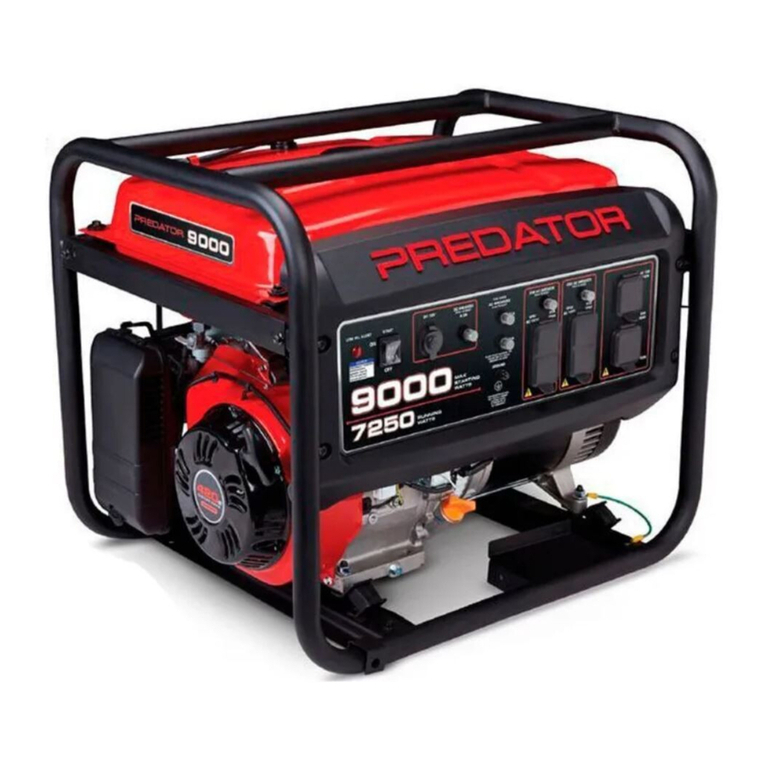
Predator
Predator 59206 user manual

Champion Global Power Equipment
Champion Global Power Equipment 201223 quick start guide

Generac Power Systems
Generac Power Systems GP3250 specification
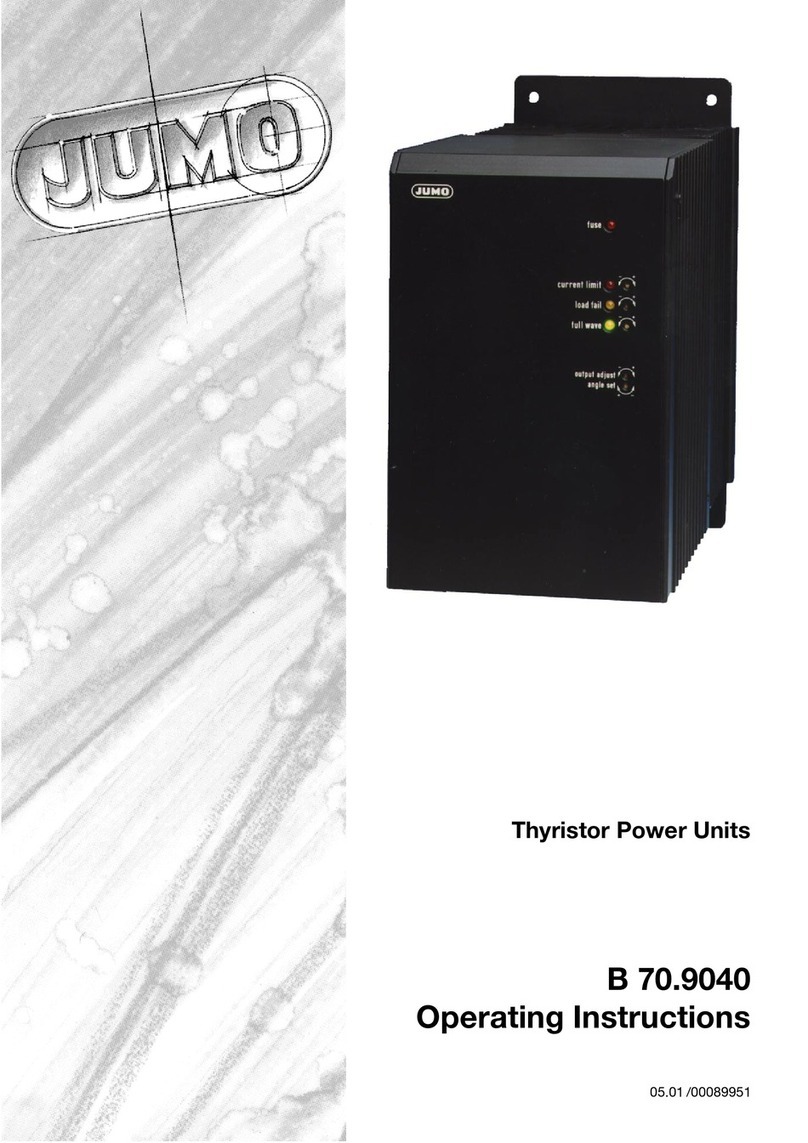
JUMO
JUMO B 70.9040 operating instructions

Makita
Makita G2800I Instructions for use
